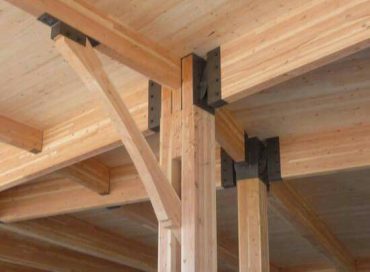
John Bleasby
Responsible material choices from the ground up
Canadian ContractorReflect a concern for the planet without being radical
Making decisions regarding the use of responsible, sensible building materials is really a matter of considering all the factors that go into that component’s production, delivery and installation. For builders looking to attract the increasing number of clients with environmental consciousness, many options can be considered.
The buzz word is “sustainability”, an over worked, over-used and exploited term that has been hijacked by marketers of almost every product imaginable (see previous coverage). In the truest sense of the word, however, when it comes to material choices, here are parameters you and your clients could consider.
Is it locally sourced?
The carbon resulting from transporting material around the country or the world is a negative.
How is it manufactured?
The term is “embodied energy”. If the producing factory and its processes results in smoke, gasses, waste or destruction of the environment in ways that are not easily or quickly renewable, it works against any claim of improved energy-efficiency on site.
Is it appropriate given the climatic conditions?
If degradation results in the need for early or regular replacement because the material is not suited to the application due to, for example, humidity or temperatures encountered at the site, it is wasteful product over time.
Does it create excessive waste?
Manufactured or pre-assembled materials and components can reduce the amount of scrap on site that is often diverted to the landfill. A the least, scrap should eligible for recycling.
Starting from the ground level through to completion, here’s a look at some material that can be presented to your clients as responsible choices.
Concrete
Surprises, surprise! Concrete actually wins points for a number of reasons. Its prime raw material is limestone, said to be the most abundant material on the planet. It can be mixed with a number of waste by-products from other industries to make a better product, like the fly ash, slag cement, and silica fume coming from power plants, steel mills and numerous manufacturing processes.
Fly ash is particularly appealing because it chemically reacts with lime to create more CSH, the same “glue” produced by the hydration of cement and water. That paste becomes stronger over time and closes off more of the capillaries that allow the movement of moisture through the concrete, resulting in a stronger, more durable concrete.
In addition to its inherent durability, concrete’s thermal mass in walls and floors can absorb passive heat and reflect solar radiation. It is also produced locally and delivered in batches suited to each project, reducing transportation carbon and wastage.

Engineered structural materials are not only strong but attractive if left exposed.
Engineered structural materials
We’re talking beams and studs made from recycled or reconstituted wood that are used as chips, strands or fingerjoints. Being processed from recycled wood waste, they are more ecological mindful. The manufacturing tolerances in terms of stability, straightness and strength can mean more precision and less material mass required, and less bowing over spans
Composite lumber
It’s already a popular choice for outdoor projects such as decks due to the reduced maintenance requirements and long life. Composite lumber resists rot, mold and insects. Because it requires less maintenance in terms of regular coatings of chemical preservatives and stains, it reduces harm to the environment beyond its own manufacture.
Structured Insulated Panels (SIPs)
You’ll be hearing more and more over time about SIPs in residential construction. SIPs are factory-built with precision (ie. as good as the information given to the factory) and are quick to assemble on site, all of which means less labour, earlier enclosure of the building and reduced waste. They also incorporate insulation of various types: foams of different types, cellulose, even hemp and straw. As their popularity increases, and more manufactures come forward, SIP prices will come down through competition. More factory features like window/door cut-outs with bucks will be increasingly available. Stay tuned. This might be the way you will build your projects in the next decade.

Bamboo is available as flooring, sheet products for feature walls, even furniture (foreground), and comes in various colors and textures (photo: John Bleasby)
Plant-based rigid insulation
Inch for inch, foam delivers more R-value than fibreglass. However, the chemical makeup of many types of foam draws criticism. Plant-based rigid foam, using fibres from bamboo, kelp or hemp, are not only great insulators but are also resistant to pests and mold. They can be used everywhere: walls, ceiling and floors.
Recycled Steel beams
Steel is strong and therefore can reduce the amount of other materials when it comes to posts and beams. Being recycled from cans, cars, and almost everything else made of metal and thus bypassing the landfill means the environmental impact is greatly reduced.
Bamboo and cork
Moving into interior finishing, bamboo and cork are great choices for floors and walls. Bamboo is a fast-growing resource and available in harder-then-oak tongue and groove flooring or sheet products in numerous colors and textural patterns that offer incredible strength-to-weight rations. And it’s very reasonably priced.
Cork is a wonderful flooring choice too, given its warmth under foot. It’s also very sound absorbing, a good thermal insulator, and resilient. Although transportation from where cork is harvested to the project location is a negative, the fact that cork comes from tree bark that will regrow makes it an earth-friendly choice.
The list is long and growing. Some choices require some source research on the part of the contractor/builder, and not all are suitable in all projects. However, the options are there for those truly interested in offering clients some unique and conscious-abiding choices.
Got feedback? Make your opinion count by using the comment section below,
or by sending an email to:
JBleasby@canadiancontractor.ca
Follow John on Instagram and on Twitter for notifications about his latest posts

![]()

Leave a Reply